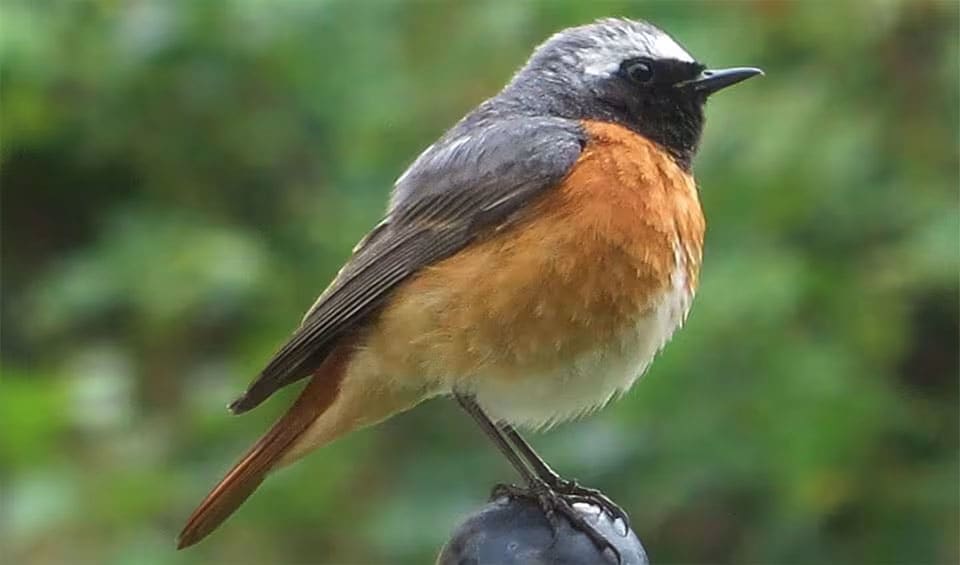A striking bird species known for its bold black, grey, and white plumage, with males boasting a distinctive rusty-orange or red tail that catches the eye. In contrast, females and juveniles exhibit a more subdued brownish-gray tone, allowing them to blend in seamlessly with their surroundings. These small to medium-sized birds are widely distributed across Europe, Asia, and parts of North Africa, where they inhabit a variety of habitats ranging from open woodlands and scrublands to mountainous regions.
During the breeding season, Common Redstarts are known for their preference for nesting sites in tree hollows or concealed areas, where they construct cup-shaped nests from twigs, grass, and other plant materials. They are agile fliers, capable of capturing insects both in mid-air and on the ground with impressive precision. One of the most charming aspects of these birds is their animated tail movements, which they often display while foraging or during courtship displays.
Despite their relatively small size, Common Redstarts are migratory birds, with populations from northern and central Europe embarking on extensive journeys to southern Europe and Africa for the winter months. This seasonal migration is driven by the need to escape harsh winter conditions and seek out more favorable habitats with abundant food resources.
Distribution
 Afghanistan
Afghanistan Albania
Albania Algeria
Algeria Andorra
Andorra Armenia
Armenia Austria
Austria Azerbaijan
Azerbaijan Bahrain
Bahrain Belarus
Belarus Belgium
Belgium Benin
Benin Bosnia And Herz.
Bosnia And Herz. Bulgaria
Bulgaria Burkina Faso
Burkina Faso Cameroon
Cameroon Central Af. Rep.
Central Af. Rep. Chad
Chad Croatia
Croatia Cyprus
Cyprus Czechia
Czechia Côte D’ivoire
Côte D’ivoire DR Congo (Kinshasa)
DR Congo (Kinshasa) Denmark
Denmark Djibouti
Djibouti Egypt
Egypt Eritrea
Eritrea Estonia
Estonia Ethiopia
Ethiopia Faroe Islands
Faroe Islands Finland
Finland France
France Gambia
Gambia Georgia
Georgia Germany
Germany Ghana
Ghana Gibraltar
Gibraltar Greece
Greece Guinea-Bissau
Guinea-Bissau Hungary
Hungary Iceland
Iceland Iran
Iran Iraq
Iraq Ireland
Ireland Israel
Israel Italy
Italy Jordan
Jordan Kazakhstan
Kazakhstan Kenya
Kenya Kuwait
Kuwait Kyrgyzstan
Kyrgyzstan Latvia
Latvia Lebanon
Lebanon Liberia
Liberia Libya
Libya Liechtenstein
Liechtenstein Lithuania
Lithuania Luxembourg
Luxembourg Mali
Mali Malta
Malta Mauritania
Mauritania Moldova
Moldova Mongolia
Mongolia Montenegro
Montenegro Morocco
Morocco Netherlands
Netherlands Niger
Niger Nigeria
Nigeria North Macedonia
North Macedonia Norway
Norway Oman
Oman Pakistan
Pakistan Poland
Poland Portugal
Portugal Qatar
Qatar Romania
Romania Russia
Russia Rwanda
Rwanda Saudi Arabia
Saudi Arabia Senegal
Senegal Serbia
Serbia Seychelles
Seychelles Sierra Leone
Sierra Leone Slovakia
Slovakia Slovenia
Slovenia Somalia
Somalia South Sudan
South Sudan Spain
Spain Sudan
Sudan Sweden
Sweden Switzerland
Switzerland Syria
Syria Tajikistan
Tajikistan Tanzania
Tanzania Togo
Togo Tunisia
Tunisia Turkmenistan
Turkmenistan Turkey
Turkey UAE
UAE Uganda
Uganda Ukraine
Ukraine United Kingdom
United Kingdom Yemen
Yemen Zimbabwe
ZimbabweAnything we've missed?
Help us improve this page by suggesting edits. Glory never dies!
Suggest an editGet to know me
Terrestrial / Aquatic
Altricial / Precocial
Polygamous / Monogamous
Dimorphic (size)/ Monomorphic
Active: Diurnal / Nocturnal
Social behavior: Solitary / Pack / Herd / Flock
Diet: Carnivore / Herbivore / Omnivore / Piscivorous / Insectivore
Migratory: Yes / No
Domesticated: Yes / No
Dangerous: Yes / No




